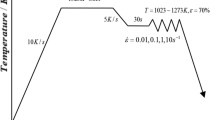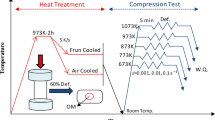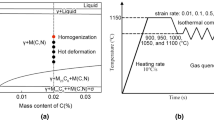Abstract
The hot deformation behavior of a multi-direction forged (MDFed) T2 copper was investigated by the isothermal compression test at deformation temperatures between 673 and 1173 K and strain rates between 0.001 and 10 s− 1. The results reveal that the deformation characteristics of the flow stress are sensitive to the hot deformation parameters. The deformation activation energy of the MDFed copper under the test conditions was calculated as 195.601 kJ/mol. The constitutive behavior was described by a two-stage constitutive model, which is based on the stress–dislocation relation and kinetics of dynamic recrystallization (DRX). Based on the dynamic material model, the three-dimensional (3D) processing maps were established to identify the instability regions and optimal hot processing parameters. It is found that DRX occurred in all the stability and instability regions, and the optimal processing conditions are in the temperature range of 923–1023 K and strain rate range of 0.1–1 s− 1, which indicates a feature of incomplete DRX. Moreover, the grains overgrew at high deformation temperatures and low strain rates, resulting in a poor workability for the MDFed copper.


















Similar content being viewed by others

References
Park KT, Park L, Kim HJ, Kim SB, Lee CS (2013) Dynamic tensile extrusion behavior of coarse grained and ultrafine grained OFHC Cu. Mater Sci Eng A 569:61–70
Tian WH, Fan AL, Gao HY, Luo J, Wang Z (2003) Comparison of microstructures in electroformed copper liners of shaped charges before and after plastic deformation at different strain rates. Mater Sci Eng A 350:160–167
Xiao YH, Guo C, Guo XY (2011) Constitutive modeling of hot deformation behavior of H62 brass. Mater Sci Eng A 528:6510–6518
Prasad YVRK, Rao KP (2005) Processing maps and rate controlling mechanisms of hot deformation of electrolytic tough pitch copper in the temperature range 300–950 °C. Mater Sci Eng A 391:141–150
Huang SH, Shu DY, Hu CK, Zhu SF (2016) Effect of strain rate and deformation temperature on strain hardening and softening behavior of pure copper. Trans Nonferrous Metals Soc China 26:1044–1054
Zhang HM, Wang J, Chen Q, Shu DY, Wang CP, Chen G, Zhao ZD (2019) Study of dynamic recrystallization behavior of T2 copper in hot working conditions by experiments and cellular automaton method. J Alloys Comp 784:1071–1083
Zhang Y, Huili S, Volinsky AA, Tian B, Chai Z, Liu P, Liu Y (2016) Hot deformation and dynamic recrystallization behavior of the Cu–Cr–Zr–Y Alloy. J Mat Eng Perform 25:1150–1156
Shukla AK, Murty SVSN, Sharma SC, Mondal K (2015) Constitutive modeling of hot deformation behavior of vacuum hot pressed Cu–8Cr–4Nb alloy. Mater Des 75:57–64
Follansbee PS, Kocks UF (1988) A constitutive description of the deformation of copper based on the use of the mechanical threshold stress as an internal state variable. Acta Metall 36:81–93
Ji GL, Li Q, Ding KY, Yang L, Li L (2015) A physically-based constitutive model for high temperature deformation of Cu–0.36Cr–0.03Zr alloy. J Alloys Comp 648:397–407
Ji GL, Li Q, Li L (2014) A physical-based constitutive relation to predict flow stress for Cu–0.4 Mg alloy during hot working. Mater Sci Eng A 615:247–254
Meng L, Wang M, Liu X, Wang F (2016) Hot compression deformation behavior and a modified physically-based constitutive model of Cu-6%Ag alloy. Appl Phys A 122:387
Raj R (1981) Development of a processing map for use in warm-forming and hot-forming processes. Metall Trans A 12:1089–1097
Liu J, Cui ZS, Li CX (2008) Analysis of metal workability by integration of FEM and 3-D processing maps. J Mater Proc Technol. 205:497–505
Wang KX, Zeng WD, Zhao YQ, Lai YJ, Zhou YG (2010) Hot working of Ti–17 titanium alloy with lamellar starting structure using 3-D processing maps. J Mater Sci 45:5883–5891
Wu ZQ, Tang YB, Chen W, Lu LW, Li E, Li ZC, Ding H (2019) Exploring the influence of Al content on the hot deformation behavior of Fe–Mn–Al–C steels through 3D processing map. Vacuum 159:447–455
Miyajima Y, Okubo S, Abe H, Okumura H, Fujii T, Onaka S, Kato M (2015) Dislocation density of pure copper processed by accumulative roll bonding and equal-channel angular pressing. Mater Charact 104:101–106
Shakhova I, Yanushkevich Z, Fedorova I, Belyakov A, Kaibyshev R (2014) Grain refinement in a Cu–Cr–Zr alloy during multidirectional forging. Mater Sci Eng A 606:380–389
Li JH, Li FG, Zhao C, Chen H, Ma XK, Li J (2016) Experimental study on pure copper subjected to different severe plastic deformation modes. Mater Sci Eng A 656:142–150
Sakai T, Miura H, Yang X (2009) Ultrafine grain formation in face centered cubic metals during severe plastic deformation. Mater Sci Eng A 499:2–6
Imantalab O, Fattah-Alhosseini A, Mazaheri Y, Keshavarz M (2016) Strengthening mechanisms and electrochemical behavior of ultrafine-grained commercial pure copper fabricated by accumulative roll bonding. Metall Mater Trans A 47:3684–3693
Kumar R, Dasharath S, Kang P, Koch CC, Mula S (2015) Enhancement of mechanical properties of low stacking fault energy brass processed by cryorolling followed by short-annealing. Mater Des 67:637–643
Wusatowska-Sarnek AM, Miura H, Sakai T (2002) Nucleation and microtexture development under dynamic recrystallization of copper. Mater Sci Eng A 323:177–186
Chen XM, Lin YC, Chen MS, Li HB, Wen DX, Zhang JL, He M (2015) Microstructural evolution of a nickel-based superalloy during hot deformation. Mater Des 77:41–49
Chen G, Chang XS, Zhang JX, Sun JYU,C, Chen Q, Zhao ZD (2019) Microstructures and mechanical properties of in-situ Al3Ti/2024 aluminum matrix composites fabricated by ultrasonic treatment and subsequent squeeze casting. Met Mater Int:1–11
Feng D, Zhang XM, Liu SD, Deng YL (2017) Constitutive equation and hot deformation behavior of homogenized Al–7.68Zn–2.12Mg–1.98Cu–0.12Zr alloy during compression at elevated temperature. Mater Sci Eng A 608:63–72
Zener C, Hollomon JH (1944) Effect of strain rate upon plastic flow of steel. J Appl Phys 15:22–32
Sellars CM, McTegart WJ (1966) On the mechanism of hot deformation. Acta Metall 14(9):1136–1138
Jonas J, Sellars CM, Tegart WJ (1969) Strength and structure under hot-working conditions. Metall Rev 14:1–24
Shi H, Mclaren AJ, Sellars CM, Shahani R, Bolingbroke R (1997) Constitutive equations for high temperature flow stress of aluminium alloys. Mater Sci Technol 13:210–216
Huang SH, Chai SX, Xia XS, Chen Q, Shu DY (2016) Compression deformation behavior and processing map of pure copper. Strength Mater 48:98–106
Estrin Y, Mecking H (1984) A unified phenomenological description of work hardening and creep based on one-parameter models. Acta Metall 32:57–70
Busso EP, Mcclintock FA (1996) A dislocation mechanics-based crystallographic model of a B2-type intermetallic alloy. Int J Plast 12:1–28
Jonas JJ, Quelennec X, Jiang L, Martin É (2009) The Avrami kinetics of dynamic recrystallization. Acta Mater 57:2748–2756
Wu B, Li MQ, Ma DW (2012) The flow behavior and constitutive equations in isothermal compression of 7050 aluminum alloy. Mater Sci Eng A 542:79–87
Laasraoui A, Jonas JJ (1991) Prediction of steel flow stresses at high temperatures and strain rates. Metall Mater Trans A 22:1545–1598
Haghdadi N, Zarei-Hanzaki A, Khalesian AR, Abedi HR (2013) Artificial neural network modeling to predict the hot deformation behavior of an A356 aluminum alloy. Mater Des 49:386–391
Prasad YVRK, Gegel HL, Doraivelu SM, Malas JC, Morgan JT (1984) Modeling of dynamic material behavior in hot deformation: forging of Ti-6242. Metall Trans A 15:1883–1892
Rao KP, Prasad YVRK, Suresh K (2011) Hot working behavior and processing map of a γ-TiAl alloy synthesized by powder metallurgy. Mater Des 32:4874–4881
Sellars CM, Tegart WJ (1966) Relationship between strength and structure in deformation at elevated temperatures. Mem Sci Rev Met 63:731–745
Belyakov A, Sakai T, Miura H, Tsuzaki K (2001) Grain refinement in copper under large strain deformation. Philos Mag A 81:2629–2643
Momeni A, Ebrahimi G, Jahazi M, Bocher P (2014) Microstructure evolution at the onset of discontinuous dynamic recrystallization: A physics-based model of subgrain critical size. J Alloys Comp 587:199–210
Hallberg H, Wallin M, Ristinmaa M (2010) Simulation of discontinuous dynamic recrystallization in pure Cu using a probabilistic cellular automaton. Comput Mater Sci 49:25–34
Acknowledgements
The authors express their appreciation for the financial support of National Natural Science Foundation of China under Grant Nos. 51875121 and 51905122, Natural Science Foundation of Shandong Province under Grant No. ZR2019MEE039, and Plan of Key Research and Development in Shandong Province under Grant No. 2017GGX202006 and 2019GGX102046.
Funding
This study was funded by National Natural Science Foundation of China (Nos. 51875121 and 51905122), Natural Science Foundation of Shandong Province (No. ZR2019MEE039), Plan of Key Research and Development in Shandong Province (No. 2017GGX202006 and 2019GGX102046).
Author information
Authors and Affiliations
Corresponding author
Ethics declarations
Conflict of interest
The authors declare that they have no conflict of interest.
Additional information
Publisher's note
Springer Nature remains neutral with regard to jurisdictional claims in published maps and institutional affiliations.
Rights and permissions
About this article
Cite this article
Zhang, H., Wang, J., Liu, G. et al. Constitutive behavior and hot workability of multi-direction forged T2 copper during hot compression deformation. Int J Mater Form 13, 479–492 (2020). https://doi.org/10.1007/s12289-020-01557-w
Received:
Revised:
Accepted:
Published:
Issue Date:
DOI: https://doi.org/10.1007/s12289-020-01557-w



